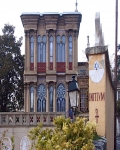Casamaures
Archaeology »
Archaeological Monuments » Casamaures
Casamaures - France
Casamaures is located in Saint-Martin-le-Vinoux, France.
Casamaures monument was established on 1855.
Primary threats to Casamaures :
Joseph Julien Cochard, inhabitants of Grenoble, buys a parcel of land along the Isere, in the foothills of the Chartreuse, to build a palace style neo-Moorish fully in molded cement.
Historical facts of Casamaures :
- Casamaures is a historically significant mansion located in the Isère department of southeastern France. Its construction and unique architectural style make it a noteworthy landmark in the region. With a rich history spanning several centuries, Casamaures stands as a testament to the cultural and architectural heritage of France.
- The story of Casamaures begins in the mid-19th century when François Joseph Eugène Neyron, a wealthy businessman and art collector, commissioned the construction of the mansion. Inspired by his travels to North Africa and the Middle East, Neyron sought to create a residence that blended Oriental and Moorish architectural elements. He enlisted the renowned architect Charles-Auguste Questel, known for his expertise in Orientalist designs, to bring his vision to life.
- Construction of Casamaures commenced in 1854 and took several years to complete. The mansion was meticulously designed with intricate details and exquisite craftsmanship. Its façade features a striking combination of terracotta bricks and painted ceramic tiles, while the interior is adorned with ornate plasterwork, colorful tile mosaics, and elaborate woodwork.
- The architectural style of Casamaures reflects the Orientalist movement that was popular in Europe during the 19th century. This movement was characterized by a fascination with the cultures and aesthetics of the East, particularly North Africa and the Middle East. Casamaures stands as a remarkable example of this architectural trend, showcasing the blending of Western and Eastern elements in a harmonious and visually stunning manner.
- Over the years, Casamaures has attracted numerous visitors and admirers. Its unique charm and historical significance have made it a popular destination for tourists, architects, and art enthusiasts alike. The mansion's splendid gardens, featuring exotic plants and a tranquil atmosphere, further enhance its allure.
- In addition to its architectural significance, Casamaures has also played a role in French history. During the late 19th and early 20th centuries, the mansion served as a gathering place for intellectuals, artists, and political figures. Its salons were known for hosting lively discussions and cultural events, contributing to the intellectual and social fabric of the time.
- In the face of changing times and shifting societal dynamics, Casamaures underwent periods of neglect and deterioration. However, in recent years, efforts have been made to restore and preserve this historical gem. Restoration projects have aimed to revive the mansion's original splendor while ensuring its long-term conservation.
- Today, Casamaures stands as a testament to the cultural and architectural heritage of the region. It serves as a museum, allowing visitors to immerse themselves in the rich history and artistic beauty of the mansion. The site also hosts various cultural events and exhibitions, further showcasing its significance as a cultural landmark.
- Casamaures is not only a physical structure but also a symbol of cultural exchange and appreciation. Its Orientalist architectural style represents a dialogue between different cultures, bridging the gap between East and West. The mansion's historical significance and aesthetic appeal continue to captivate visitors, making it a cherished part of France's architectural heritage.

